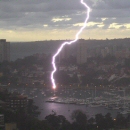Develop your system
Overview
Our objective is to design your boat lightning protection system to resemble that on a building where air terminals are around the roof perimeter, multiple down conductors are on the outside, and multiple ground rods buried outside the footings. The main difference is that we use grounding electrodes in place of ground rods, for obvious reasons. The main elements of our system are the following:
- At the top of the lightning protection system are the air terminals, the desired attachment points for the lightning channel. Make sure that the zone of protection provided by these covers all occupied areas in the vessel.
- A key component is a loop conductor above the waterline that both provides an electrostatic shield and is used for interconnections. Usually existing fittings such as aluminum toe rails or handrails can form part of this.
- A network of down conductors connected to the loop conductor and the grounding network forms a protective rib cage around the sensitive interior of the boat.
- Multiple grounding electrodes are distributed around the hull's perimeter. The bulk of these are SiedarcTM electrodes that are installed just above the waterline to initiate extensive discharges over the water's surface, while at least two immersed hStrips are located outboard of immersed fittings such as propellers and thrusters to bypass these fittings.
- Bonding conductors are also attached between metallic fittings and the lightning conductor system. Note that shielding by means of external conductors is an effective way to equalize potentials and is the only method that can be used for conductors such as water tanks and crew members that cannot be bonded with connecting wires. In this way we equalize potentials inside the boat to reduce sideflash likelihood.
Design your own
Sailboat
The distinctive feature in a sailboat is the pre-existing lightning rod that carries the sails. If the mast is aluminum it can be used as a main down conductor, although it is advisable to add an air terminal at the masthead for protection of transducers. If the mast is carbon fiber then using it as a down conductor may result in its destruction. Likewise, aluminum toe rails can be used as a substantial part of the loop conductor, as can arches and pulpits.
MotoryachtOn a powerboat, existing conducting fittings such as handrails, outriggers, T-tops, biminis, and metallic superstructures can form an integral part of the system. Since we already have a network of down conductors that are predominantly near the outside of the hull, the natural location for air terminals is also around the perimeter and these can be mounted on metal handrails, inside composite handrails, and on the tops of roofs.
Useful links
- Similar systems
Our Systems Gallery page has diagrams and information for many of our systems. Look through these to see if we have already designed a system for a similar vessel to your own.
- Information
The topics in the INFORMATION menu explain several relevant aspects of basic science, system design and components. Of particular relevance to designing your own system are:
- Air terminals explains the basic function of an air terminal, the zone-of-protection concept, and why dissipators should not be used.
- Articles presents several in-print and on-line articles dealing with fundamental concepts, our system and our products.
- Grounding concepts discusses fundamental physical concepts that are applicable to lightning protection on the water.
- Grounding guide shows how to use SiedarcTM electrodes in a marine lightning grounding system.
- Lightning describes the discharge processes involved in a strike to a boat.
- Solutions discusses the general approach to lightning protection using external conductors and explains some specific hazards and techniques for different types of boats.
- Products
The PRODUCTS menu describes our product line that includes:
Ask us
Although there are common features to all systems, every system typically has customized aspects. We can help with the specifics for individual product details up to complete systems. Please send us an email including a brief description of your vessel, your approximate budget, your phone number and photos or design drawings. After a quick review of your requirements, we will call you back and discuss your options. While more extensive analysis may involve additional consulting, this initial consultation is free of charge.
Contact
Marine
Lightning Protection Inc.
3215 NW 17th Street
Gainesville
Florida 32605
|
|
|
|
|
